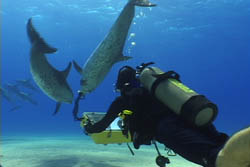
My First Massacre
The Tragic Story of Dolphins at Iki
In 1978 I first heard of the terrible slaughter of dolphins at Iki Island, Japan. In Hawaii filming my first film on dolphins, I saw a picture in the local paper of hundreds of dolphins dead on a beach on an island off southern Japan.
By that time I was a bona fide dolphin lover, having just spent time swimming with and filming a pod of spinner dolphins off Lanai. The pictures from Japan shocked and horrified me. I could not imagine how people could deliberately kill dolphins.
I went to Iki in 1979 and 1980 as well as in later years, most recently 2006. Some interesting facts emerged from those visits.
Until 1971 dolphins had not been a problem at Iki. But in that year a current broke off from the main Kuroshio Current running from the Philippines past the eastern coast of Japan and changed the distribution of fish around Iki, bringing fish dolphins prey upon. At the same time the Japanese were overfishing their own waters and the Shichiriga Banks off Iki were one of the few areas where abundant quantities of fish could still be found. The dolphins may have been forced to Iki by shortage of fish elsewhere.
By the mid 1970s so many dolphins migrated through the area off Iki that fishermen began to worry they would consume too many fish. Their catch was falling and they were terrified. But overfishing was the culprit (plus pollution in the breeding areas) not dolphins. The Iki islanders brought in a fisheries expert who said there might be as many as 300-thousand dolphins passing by, each eating 20 pounds of fish a day. The fishermen did the math and concluded they were at war with the dolphins – a typical resource war. They began by shooting and harpooning them. Then they learned from fishermen at Taiji the Oi Komi technique of banging on metal poles stuck in the water to make painful sounds that would drive the dolphins into a bay where they would be slaughtered.
In 1978 the first mass murder of dolphins took place. The fishermen, surprisingly, had invited the media to record the event which resulted in the photos syndicated around the world, one of which I saw in Hawaii. Amazingly the fishermen thought that showing how many dolphins were in their fishing grounds would spur the government to action to eradicate the dolphins or to pay a bounty on them. Follow the money!
In 1979 I brought a film crew to Iki. We interviewed the fishermen, went out on their boats but never saw a dolphin. I made a film in which I tried to understand (not agree with) why these fishermen, who were astonishingly decent and hospitable people, would brutally slaughter as many as two thousand dolphins. They did it to protect their livelihood. It was a them or us mentality.
In 1980 I returned with Howard Hall, then a neophyte underwater cameraman, today one of the preeminent marine cinematographers in the world. We went first to Taiji where we turned our cameras on a group of 200 melonheaded whales that had been captured and were slated for slaughter. Fearing a worldwide scandal if the killing were filmed they let the dolphins go.
Howard and I then went on to Iki where we walked straight into a brutal massacre of up to 2,000 dolphins. We shot film. I got it to Tokyo where CBS News processed it and satellited it around the world, causing a massive backlash against Japan.
Dexter Cate, an environmentalist from Hawaii, untied some of the nets holding those dolphins not yet killed. He was arrested, tried and sent to prison but released fairly quickly. His action brought further attention to the situation at Iki.
Late in March of 1980 local and prefectural governments told the Iki Islanders they should not hunt dolphins – at least until things cooled down. There was no hunting until the mid 1980s when dolphin slavers came to Iki with money in hand and incited an oi komo roundup resulting in the taking into captivity of dozens of dolphins and the slaughter of hundreds.
During my most recent visit to Iki I learned that there are no dolphins in the waters around Iki today. There is no consensus as to why. One plausible answer is that water temperatures have changed, removing the prey that first attracted dolphins to Iki during the 1970s. Squid boats now find their catch far to the north of Iki and report there are dolphins in those waters. The fish that have left Iki waters have been replaced by more southerly species as the waters warm. The fishermen are catching tuna for the first time.
The irony is that dolphins for captivity have become so valuable that the Iki Islanders wish they would come back so they could capture and sell them.
At Futo, where dolphins had been hunted for years, the latest hunts occurring in 1999 and 2004, bottlenose dolphins have disappeared and are found on the other side of the Izu peninsula. This certainly has to do with a change in water temperatures. I can’t say the dolphins learned to avoid Futo because they were hunted for decades and always appeared offshore until very recently. But larger forces are at work in the oceans today.


2 comments:
Omg. Bottomline,protested at 16. Appalled then and now.
Sadece götten sikiş yapanların anal porno ve bakire sex video sahneleri
Post a Comment